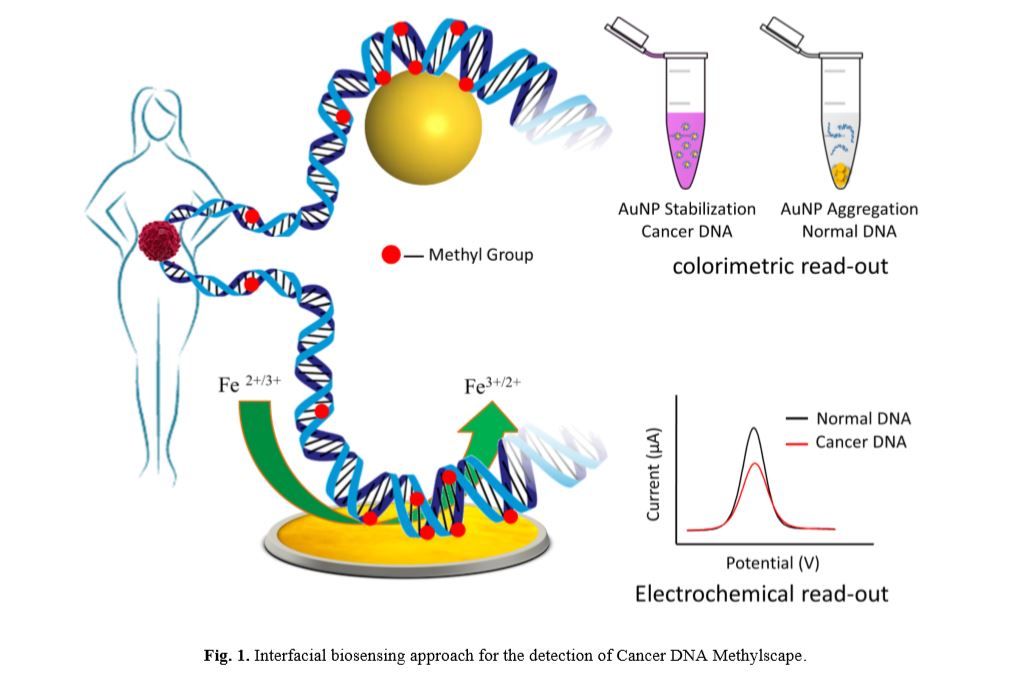Video Article Open Access
Interfacial Biosensing: A New Avenue of Nano-Biosensing at the Metal Interface for Detecting Cancer Biomarkers
Abu Ali Ibn Sina*, Laura G. Carrascosa, Matt Trau
Center for Personalized Nanomedicine, Australian Institute for Bioengineering and Nanotechnology (AIBN), The University of Queensland, Brisbane QLD 4072, Australia
Vid. Proc. Adv. Mater., Volume 2, Article ID 2021-0156 (2021)
DOI: 10.5185/vpoam.2021.0156
Publication Date (Web): 09 Feb 2021
Copyright © IAAM
Graphical Abstract

Abstract
Interfacial biosensing is an emerging nano-biosensing research field which harnesses the differential adsorption interactions of biological species (e.g. DNA, RNA, proteins) with bare metal surfaces for direct biomolecule detection and analysis [1,2]. During disease progression, biomolecules commonly undergo considerable changes in their molecular structure and three-dimensional conformation, as compared to their normal states [1,2]. This can significantly alter the biomolecules’ physicochemical properties to affect adsorption interactions with metallic surfaces. Interfacial biosensing innovatively exploits the adsorption behaviour of biomolecules in a novel fashion to enable a new age of clinical translation-directed nano-biotechnologies for genomic, transcriptomic and proteomic analysis. More importantly, it can overcome major technological drawbacks of current biosensing approaches by i) obviating the need for surface biofunctionalization steps and ii) significantly reducing the analysis time and assay cost [1,2]. Over the last 5 years, we have extensively explored this unique sensing approach and developed many optical, electrochemical and microfluidic sensors for detecting different cancer biomarkers such as DNA methylation and protein phosphorylation [3-5]. The most recent one includes the 10 minute cancer test based on interfacial biosensing which utilizes the universal DNA nano-signature to identify the cancer DNA from any tissue type e.g. blood or biopsy [3]. This presentation shall review these developments highlighting the applicability of interfacial biosensing via bare gold-biomolecule affinity for detecting cancer associated biomolecular changes. We anticipate that the simplicity of this method, along with the high level of accuracy for identifying the disease associated biomolecular changes could find broad application in biology and diagnostics.
Keywords
Interfacial biosensing; nano-biotechnology, cancer Diagnostics; DNA methylation, protein phosphorylation.
Acknowledgement
This work was supported by NHMRC Investigator Grant (APP1175047), Australian Research Council Discovery Project (DP120102503, DP180102868) and National Breast Cancer Foundation of Australia (CG-12-07).
References
- A. A. I. Sina, K. M. Koo, M. Ahmed, L. G. Carrascosa, M. Trau, In: Wandelt, K., (Ed.) Encyclopedia of Interfacial Chemistry: Surface Science and Electrochemistry, Elsevier; 2018, vol. 7, pp 269-277.
- K. M. Koo, A. A. I. Sina, L. G. Carrascosa, M. J. A. Shiddiky, M. Trau, Analytical Methods, 2015, 7, 7042-7054.
- A. A. I. Sina, L. G. Carrascosa, L. Ziyu, Y. S. Grewal, A. Wardiana, M. J. A. Shiddiky, R. A. Gardiner, H. Samaratunga, M. Gandhi, R. Scott, D. Korbie, M. Trau, Nature Communications, 2018, 9, 4915.
- A. Wuethrich, A. A. I. Sina, M. Ahmed, T-Y. Lin, L. G. Carrascosa, M. Trau, Nanoscale, 2018, 10, 10884-10890.
- A. A. I. Sina, L. G. Carrascosa, R. Palanisamy, S. Rauf, M. J. A. Shiddiky, M. Trau, Anal. Chem. 2014, 86, 10179-10185.
Biography
Abu Ali Ibn Sina is currently a National Health and Medical Research Council’s Emerging Leader fellow at the Australian Institute for Bioengineering & Nanotechnology (AIBN), The University of Queensland, Australia. He obtained his PhD from the University of Queensland in 2017. He was an Assistant Professor (equivalent to Senior Lecturer) at the Department of Biochemistry and Molecular Biology, Shahjalal University of Science & Technology, Bangladesh. Prior to joining the academia, he held positions in multinational companies such as Berger Paints and Beximco Limited. He is one of the main inventors of DNA nano-signature based cancer test dubbed as 10-minute universal cancer test which has been highlighted in >400 leading international news outlets articles including CNN, The Guardian, Forbes, etc. He also had appearances in many national and international television and radio channels. He has a wide range of experiences in the industry, teaching and research with strong communication, team building, analytical and research skills. He published 30 research articles including 2 book chapters. Most of his works are published in high quality journals like Nature Communications, Accounts of Chemical Research, Science Advances, Advanced Functional Materials, Biosensors and Bioelectronics, Nanoscale, Lab on a Chip and Analytical Chemistry etc. He presented his research works in several national and international conferences and seminars. He is also engaged in several social organizations. His vision is to develop the point of care diagnostic technologies for early detection of diseases which potentially could deliver a healthier and better life to the human.
Video Proceedings of Advanced Materials

Upcoming Congress



